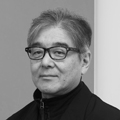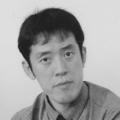- ExhibitionsTOTO GALLERY·MA
- Upcoming Exhibitions
- Past Exhibitions
- ExhibitionsExternal Locations
- Upcoming Exhibitions
- Past Exhibitions
- Lectures
- Upcoming Lectures
- Past Lectures
- Visitor Information
- Directions
- Gallery Infomation
- Museum Shop
- Bookshop TOTO
Cultural Activities
TOTO GALLERY·MA
TOTO Publishing
Bookshop TOTO

About the Exhibitor
Explanation of Exhibits
Kenzo Tange, the representative architect of postwar Japan, held a deep affection for photography. He photographed not only his own buildings and family but also numerous works of old Japanese architecture. In 1960, Tange, together with photographer Yasuhiro Ishimoto, architect Walter Gropius, and graphic designer Herbert Bayer, published a photo book titled KATSURA (Zokeisha, 1960), which not only questioned the conventional historical perspectives on Japanese architecture but also demonstrated both how the expressive medium of photography could become a creative driving force for making modern architecture and how seeing could be tied directly to creating.
Although some may already be familiar with Tange’s photographs that have been used in architectural journals and anthologies of his work, this exhibition that places its focus on Tange’s eye brings into view many previously unpublished prints. This allows us to understand which parts of his own work Tange tried to frame within his viewfinder and what he persistently attempted to capture in the work of those such as Michelangelo and Le Corbusier.
The majority of the photographs shown in this exhibition were taken during the 1950s. In terms of time period, they span from the time of the Hiroshima Peace Memorial Museum (1952) to around the time of the Tokyo Metropolitan Government Office (1957), the Kagawa Prefectural Government Office (1958), the Imabari City Hall Complex (1959), and Tange’s guest professorship at MIT (1959). In terms of Tange’s age, they are from when he was 36 to 46 years old. Considering that Tange was 40 when he completed the Hiroshima Peace Memorial Museum, he was by no means an early bloomer as an architect. This exhibition aims to trace Tange’s footsteps leading up to Yoyogi National Gymnasiums and Saint Mary's Cathedral, Tokyo (both completed in 1964) by looking through his eyes from the time before he became known as a great master. I invite you to feel where the moments that gave rise to his masterpieces occurred through the photographs shown in this exhibition.
Although some may already be familiar with Tange’s photographs that have been used in architectural journals and anthologies of his work, this exhibition that places its focus on Tange’s eye brings into view many previously unpublished prints. This allows us to understand which parts of his own work Tange tried to frame within his viewfinder and what he persistently attempted to capture in the work of those such as Michelangelo and Le Corbusier.
The majority of the photographs shown in this exhibition were taken during the 1950s. In terms of time period, they span from the time of the Hiroshima Peace Memorial Museum (1952) to around the time of the Tokyo Metropolitan Government Office (1957), the Kagawa Prefectural Government Office (1958), the Imabari City Hall Complex (1959), and Tange’s guest professorship at MIT (1959). In terms of Tange’s age, they are from when he was 36 to 46 years old. Considering that Tange was 40 when he completed the Hiroshima Peace Memorial Museum, he was by no means an early bloomer as an architect. This exhibition aims to trace Tange’s footsteps leading up to Yoyogi National Gymnasiums and Saint Mary's Cathedral, Tokyo (both completed in 1964) by looking through his eyes from the time before he became known as a great master. I invite you to feel where the moments that gave rise to his masterpieces occurred through the photographs shown in this exhibition.
Guest Curator Saikaku Toyokawa
Kenzo Tange (1913–2005)

Kenzo Tange, portrait. 1953. Photographer unknown.
The image was taken when Tange visited the construction site of his personal residence in Seijo, Tokyo.
The image was taken when Tange visited the construction site of his personal residence in Seijo, Tokyo.
Architect and urban planner. Born 1913 in Osaka. He graduated from the Architecture Department in the Faculty of Engineering of Tokyo Imperial University in 1938 before being employed at Mayekawa Kunio Associates, Architects & Engineers, where he worked on projects such as the Kishi Memorial Hall. After resigning this job, he became a student at the graduate school of Tokyo Imperial University and won first place in the design competition for the Greater East Asia Co-Prosperity Sphere Memorial Hall. After the war, he became an assistant professor in the Architecture Department of the Tokyo Imperial University (later renamed the University of Tokyo), where he conducted original urban analyses in the Tange Lab while also designing numerous works of public architecture that symbolized Japan’s recovery from the war. The Tange Lab is known for having produced many prominent architects and government officials, including Sachio Otani, Atsushi Shimokobe, Fumihiko Maki, Koji Kamiya, Arata Isozaki, Kisho Kurokawa, and Yoshio Taniguchi. After retiring from the University of Tokyo in 1974, he realized large-scale urban projects and super high-rise projects in places such as the Middle East, Africa, Europe, and Singapore. His international activities earned him the epithet “Tange of the World”. His representative projects include the Hiroshima Peace Memorial Museum; Tokyo Metropolitan Government Office; Kagawa Prefectural Government Office; Yoyogi National Gymnasiums; Saint Mary's Cathedral, Tokyo; Yamanashi Press and Broadcasting Center; Japan World Exposition Festival Plaza; Nigeria New Capital City Plan; and the New Tokyo City Hall Complex. His writings include Tange Kenzō: Ippon no enpitsu kara [Kenzo Tange: From one pencil] (Nihon Tosho Center, 1997).
Supervisor Profile
Waro Kishi
Architect. Born 1950 in Kanagawa Prefecture.
Professor, Department of Architecture, Faculty of Engineering, Graduate School of Engineering, Kyoto University.
Taught at the Kyoto Institute of Technology from 1993 to 2010 and served as a guest professor at the University of California, Berkeley and Massachusetts Institute of Technology during this time. Has held current post since 2010. Awarded numerous prizes including the 1993 Japan Institute of Architects Young Architect Award and the 1996 Architectural Institute of Japan Prize.
Architect. Born 1950 in Kanagawa Prefecture.
Professor, Department of Architecture, Faculty of Engineering, Graduate School of Engineering, Kyoto University.
Taught at the Kyoto Institute of Technology from 1993 to 2010 and served as a guest professor at the University of California, Berkeley and Massachusetts Institute of Technology during this time. Has held current post since 2010. Awarded numerous prizes including the 1993 Japan Institute of Architects Young Architect Award and the 1996 Architectural Institute of Japan Prize.

Guest Curator Profile
Saikaku TOYOKAWA
Architect and architectural historian. Born 1973 in Miyagi Prefecture.
Associate Professor, Department of Architecture, Oyama National College of Technology. Lecturer, Graduate School of Engineering and Science, Shibaura Institute of Technology. Doctor of Engineering and registered first-class architect.
Graduated from the Department of Architecture, Graduate School of Engineering, University of Tokyo and worked at Nikken Sekkei before assuming current post. Books include Gunzō to shite no Tange Kenkyūshitsu (Ohmsha, 2012; AIJ Book Prize).
Architect and architectural historian. Born 1973 in Miyagi Prefecture.
Associate Professor, Department of Architecture, Oyama National College of Technology. Lecturer, Graduate School of Engineering and Science, Shibaura Institute of Technology. Doctor of Engineering and registered first-class architect.
Graduated from the Department of Architecture, Graduate School of Engineering, University of Tokyo and worked at Nikken Sekkei before assuming current post. Books include Gunzō to shite no Tange Kenkyūshitsu (Ohmsha, 2012; AIJ Book Prize).

Copyright © TOTO LTD. All Rights Reserved.







